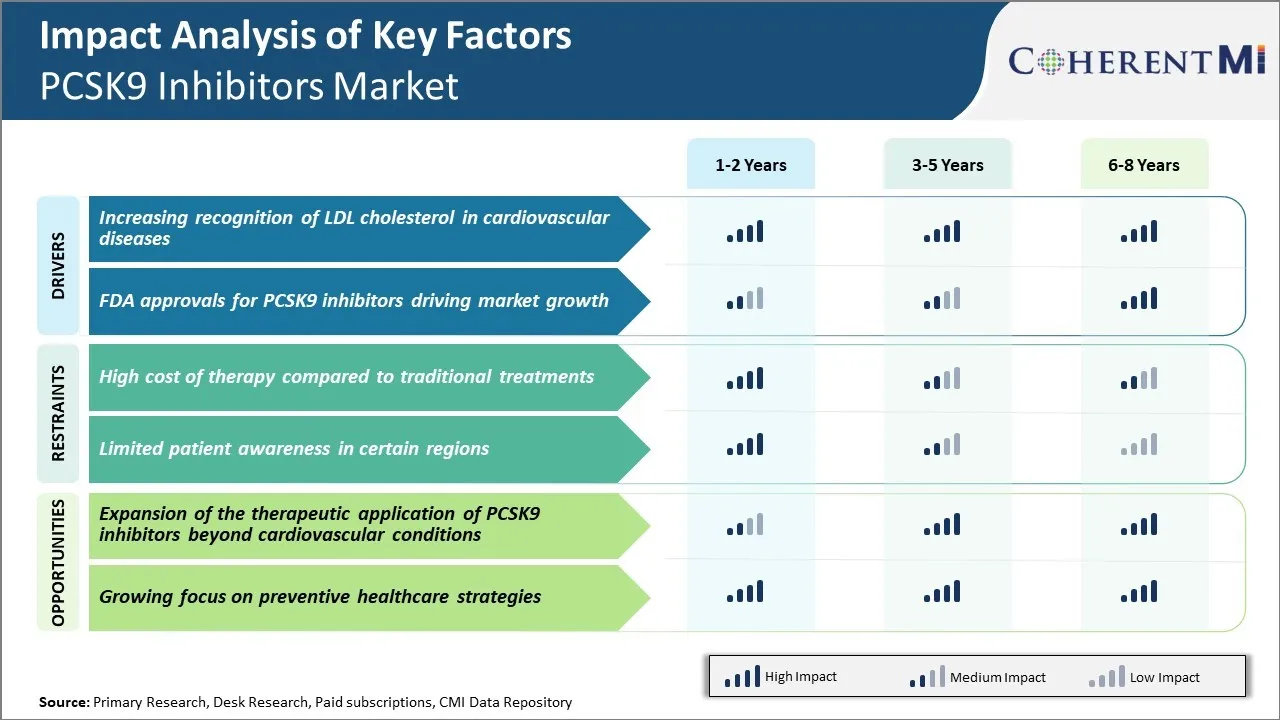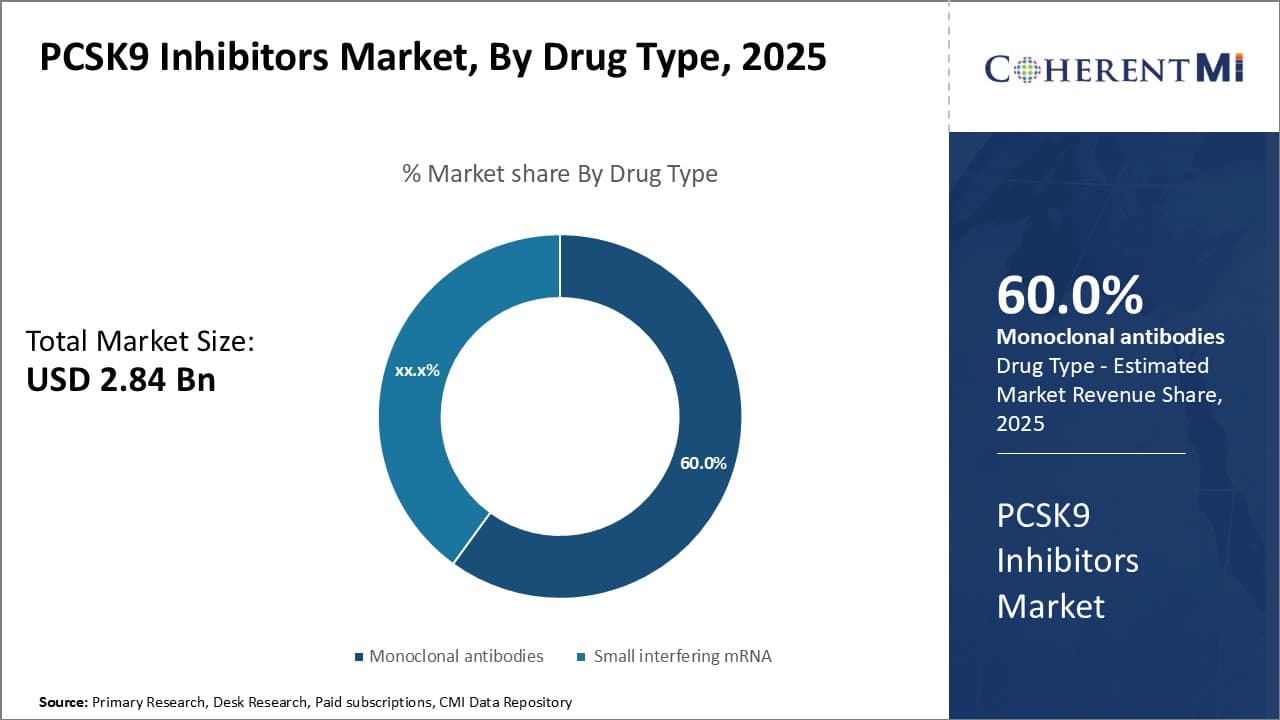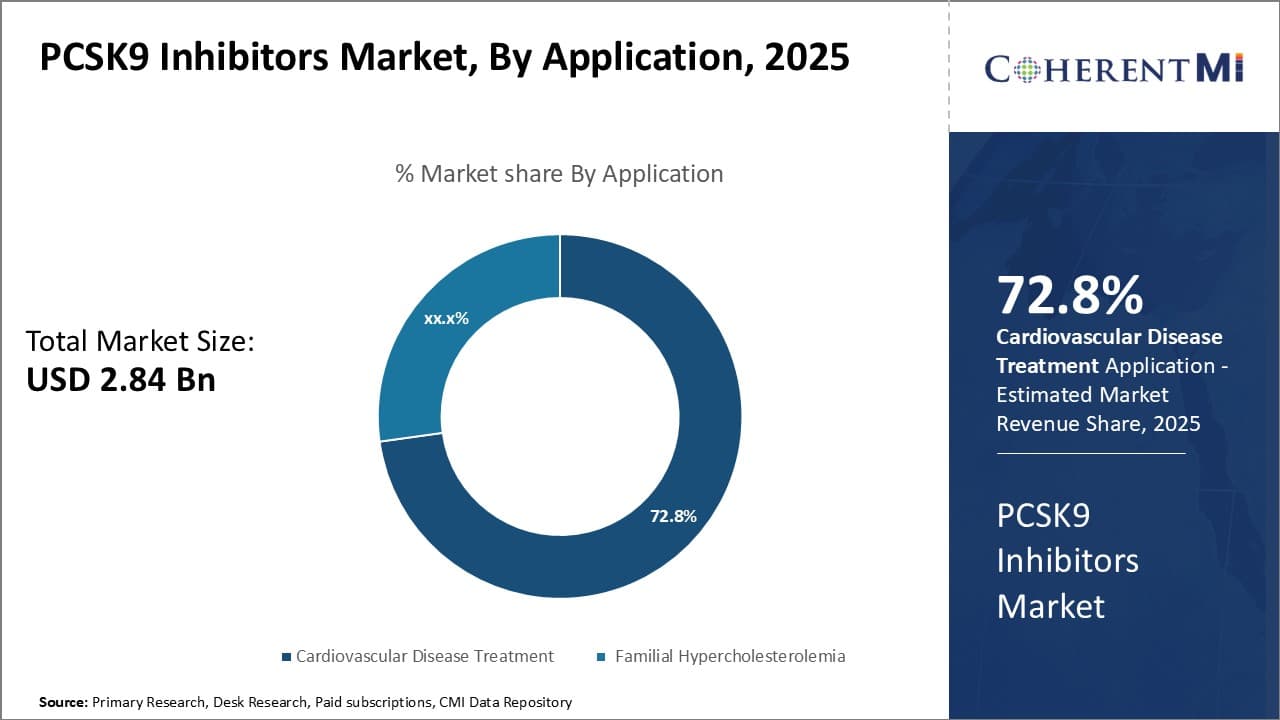

The PCSK9 inhibitors market is estimated to be valued at USD 2.84 Bn in 2025 and is expected to reach USD 8.22 Bn by 2032, growing at a compound annual growth rate (CAGR) of 16.4% from 2025 to 2032. The major factors driving the growth of this market are the increasing cases of hypercholesterolemia and cardiovascular diseases among the growing geriatric population.
Market Size in USD Bn
CAGR16.4%
| Study Period | 2025-2032 |
| Base Year of Estimation | 2024 |
| CAGR | 16.4% |
| Market Concentration | High |
| Major Players | Amgen (REPATHA), Sanofi/Regeneron (PRALUENT), Merck (MK-0616), LIB Therapeutics (LIB003), AstraZeneca and Among Others |
Market Driver - Increasing Recognition of LDL Cholesterol in Cardiovascular Diseases
The landmark Framingham Heart Study was one of the earliest large-scale investigations that demonstrated individuals with elevated LDL concentrations are twice as likely to develop coronary heart disease compared to those with normal or optimal levels. Further research has reinforced these findings and physicians globally now recognize LDL reduction as a cornerstone of management for both primary and secondary prevention of heart diseases.
Current guidelines recommend standard lifestyle changes and use of statins as first-line therapy to attain specific LDL targets based on a patient's cardiovascular risk profile.
However, even with maximally tolerated statins alone many 'high risk' individuals struggle to achieve recommended goals. This has created a clear clinical need for additional lowering therapies to fill the 'treatment gap'. PCSK9 inhibitors have emerged as a promising new class of lipid-lowering agents that act through a distinct and complementary mechanism compared to statins.
By blocking PCSK9 protein that regulates clearance of LDL receptors, they provide extra lowering of LDL levels as high as 60%. Thus, growing knowledge regarding how bad cholesterol leads to heart attacks and strokes as well as the limitations of statin therapy have propelled the potential role of PCSK9 inhibitors in cardiovascular disease prevention.
Market Driver - FDA Approvals for PCSK9 Inhibitors Driving Market Growth
The landmark FDA approvals for PCSK9 inhibitors alirocumab and evolocumab in 2015 transformed the management of hypercholesterolemia. This marked a groundbreaking advance as it was the first time a new class of lipid-lowering agents had received regulatory clearance in almost two decades. More importantly, the FOURIER and ODYSSEY outcomes trials demonstrated they significantly lowered rates of heart attacks, strokes and coronary revascularization compared to placebo in high-risk populations.
Encouraged by these positive results, both the European Society of Cardiology and American College of Cardiology revised their practice guidelines to incorporate PCSK9 inhibitors as a recommended treatment option for certain very high-risk groups. The FDA stamp of approval initiated a period of dramatic growth, helping establish PCSK9 inhibition as a mainstream therapeutic modality within a short time span.
With proven cardiovascular benefits, they have transformed into a multi-billion dollar market attracting heavy promotion from pharmaceutical companies. While initial uptake was slow due to high list prices, aggressive marketing campaigns, greater accessibility through insurance coverage and expanding clinical indications have succeeded in steadily widening their adoption globally.
The ongoing success of alirocumab and evolocumab have strengthened the clinical case for PCSK9 inhibitors and bode well for future market prospects.
 To learn more about this report, Download Free Sample Copy
To learn more about this report, Download Free Sample Copy
Market Challenge - High Cost of Therapy Compared to Traditional Treatments
One of the major challenges faced by the PCSK9 inhibitors market is the high cost of therapy compared to traditional statin treatments. PCSK9 inhibitor drugs are currently priced significantly higher than generic statins, which are the standard first-line treatment for lowering cholesterol.
For example, a year's supply of Praluent or Repatha can cost over $6000, while statins are available for just a few dollars per month. This large price difference means that PCSK9 inhibitors are currently not cost-effective compared to statins for many patients and health plans. Their use tends to be restricted to patients who are unable to tolerate statins or need additional cholesterol lowering.
For the PCSK9 inhibitors market to grow substantially, manufacturers will need to further lower drug prices to demonstrate better cost-effectiveness over the long run through reduced cardiovascular events. This price reduction is challenging given the high research and development costs associated with developing new biologic drugs.
Market Opportunity - Expansion of the Therapeutic Application of PCSK9 Inhibitors Beyond Cardiovascular Conditions
One significant growth opportunity for the PCSK9 inhibitors market is the potential expansion of therapeutic uses beyond cardiovascular indications. PCSK9 inhibitors are known to significantly lower LDL or "bad" cholesterol levels and emerging research suggests they may provide benefits for additional conditions influenced by cholesterol levels. These include non-alcoholic fatty liver disease (NAFLD), statin-associated muscle pains, and potentially even neurological disorders like Alzheimer's disease where cholesterol plays a role.
Achieving regulatory approvals for expanded labeling could open up a much larger patient population for PCSK9 inhibitors. This would help justify the higher drug prices and potentially make PCSK9 inhibition a standard of care for treating a variety of diseases over the long-term.
Pharmaceutical companies are actively investigating additional therapeutic areas for PCSK9 inhibitors which, if proven successful, could transform the market outlook into one with significant growth potential in the coming decades.
Amgen, one of the major players in the market, received FDA approval for Repatha (evolocumab) in 2015, becoming the first PCSK9 inhibitor drug approved. This gave Amgen a first-mover advantage in capturing market share. As of 2020, Repatha accounted for over 60% of the global PCSK9 inhibitor drug market.
To strengthen its monopoly position, Amgen aggressively promoted Repatha through direct-to-consumer advertising campaigns shortly after launch. Between 2015-2018, Amgen spent over $500 million on marketing Repatha through TV, print and digital ads targeting consumers and physicians. These awareness campaigns helped boost Repatha sales significantly in the initial years and established it as the market leader.
Similarly, Sanofi and Regeneron launched Praluent (alirocumab) in 2015 after FDA approval. However, they faced tough competition from the well-entrenched Repatha in the market. To play catch up, Sanofi/Regeneron offered pay-for-performance contracts to pharmacy benefit managers, lowering the net price of Praluent if certain sales thresholds were not met. This risk-sharing strategy helped increase Praluent adoption rates among physicians and patients skeptical of high list prices.
By 2018, Praluent was able to gain around 30% market share in the U.S, eating into Repatha's dominance. Its pay-for-results approach set an example that was later followed even by Amgen to maintain Repatha sales volumes. Strategic pricing practices like these have ensured a duopoly situation in the PCSK9 inhibitor market between Repatha and Praluent.
In summary, early FDA approvals, massive promotional spending, and pay-for-performance contracting strategies have been the key factors driving commercial success for major players like Amgen
 To learn more about this report, Download Free Sample Copy
Insights, By Drug Type: Efficacy and Safety Drive Demand for Monoclonal Antibodies in PCSK9 Inhibitors Market
To learn more about this report, Download Free Sample Copy
Insights, By Drug Type: Efficacy and Safety Drive Demand for Monoclonal Antibodies in PCSK9 Inhibitors Market
Within the PCSK9 inhibitors drug type segment, monoclonal antibodies such as PRALUENT and REPATHA dominate the market share due to their proven efficacy and safety profile. Several high-quality clinical trials have demonstrated the antibodies' ability to significantly lower LDL cholesterol levels in patients. For example, trials have shown REPATHA can reduce LDL cholesterol by up to 60% when used in addition to statins. This superior lowering of "bad" cholesterol translates to a reduced risk of cardiovascular events such as heart attacks and strokes.
The clinical evidence supporting the antibodies' cardiovascular risk reduction benefits physicians and patients in their treatment decisions. Both PRALUENT and REPATHA have received approvals from regulatory bodies like the FDA for use in indications such as high cardiovascular risk patients unable to reach LDL goals with statins alone. The antibodies' demonstrated efficacy in randomized control trials gives prescribers confidence they can help manage patients' cholesterol levels and reduce future health risks long-term.
Looking ahead, clinical development is ongoing to further expand the evidence base and approved indications for monoclonal antibodies. Overall, the monoclonal antibodies' record of proven efficacy and safety will continue driving utilization across indicated high-risk patient populations.
 To learn more about this report, Download Free Sample Copy
To learn more about this report, Download Free Sample Copy
Insights, By Application: Cardiovascular Disease Treatment Dominates PCSK9 Inhibitor Application
Within the application segment of the PCSK9 inhibitor market, cardiovascular disease treatment accounts for the vast majority of usage. This is due to a combination of epidemiological factors and the clinical benefits demonstrated for patients with established atherosclerotic conditions.
Clinical trials have shown PCSK9 inhibitors produce robust lowering of LDL cholesterol and major reductions in cardiovascular events across a range of cardiovascular patient populations already on statins. For example, patients with recent acute coronary syndromes experience significantly fewer subsequent heart attacks or strokes on therapy in trials like FOURIER. The potential to prevent second events and reduce disease progression makes PCSK9 inhibitors an attractive treatment option. Guidelines now recommend their consideration for very high-risk patients unable to reach LDL goals.
Within the cardiovascular disease scope, PCSK9 inhibitors are predominantly used in patients with manifestations like heart attacks, unstable angina, coronary revascularization procedures and strokes. Later trials are exploring benefits in peripheral artery disease as well. Their cholesterol-lowering benefits translate to reduced plaque progression and vulnerability, lessening atherosclerotic disease burden over the long run. This offers hope of improved survival and quality of life for patients worldwide managing cardiovascular health issues.
The major players operating in the PCSK9 Inhibitors Market include Amgen (REPATHA), Sanofi/Regeneron (PRALUENT), Merck (MK-0616), LIB Therapeutics (LIB003), and AstraZeneca.
Would you like to explore the option of buying individual sections of this report?
Vipul Patil is a dynamic management consultant with 6 years of dedicated experience in the pharmaceutical industry. Known for his analytical acumen and strategic insight, Vipul has successfully partnered with pharmaceutical companies to enhance operational efficiency, cross broader expansion, and navigate the complexities of distribution in markets with high revenue potential.
PCSK9 Inhibitors Market is segmented By Drug Type (Monoclonal antibodies, Small interfering mRNA), B...
PCSK9 Inhibitors Market
How big is the PCSK9 inhibitor market?
The PCSK9 inhibitors market is estimated to be valued at USD 2.84 Bn in 2025 and is expected to reach USD 8.22 Bn by 2032.
What are the key factors hampering the growth of the PCSK9 inhibitors market?
The high cost of therapy compared to traditional treatments and limited patient awareness in certain regions are the major factor hampering the growth of the PCSK9 inhibitors market.
What are the major factors driving the PCSK9 inhibitors market growth?
The increasing recognition of LDL cholesterol in cardiovascular diseases and FDA approvals for pcsk9 inhibitors driving market growth are the major factor driving the PCSK9 inhibitors market.
Which is the leading Drug Type in the PCSK9 inhibitors market?
The leading drug type segment is monoclonal antibodies (PRALUENT, REPATHA).
Which are the major players operating in the PCSK9 inhibitors market?
Amgen (REPATHA), Sanofi/Regeneron (PRALUENT), Merck (MK-0616), LIB Therapeutics (LIB003), AstraZeneca are the major players.
What will be the CAGR of the PCSK9 inhibitors market?
The CAGR of the PCSK9 inhibitors market is projected to be 16.4% from 2025-2032.